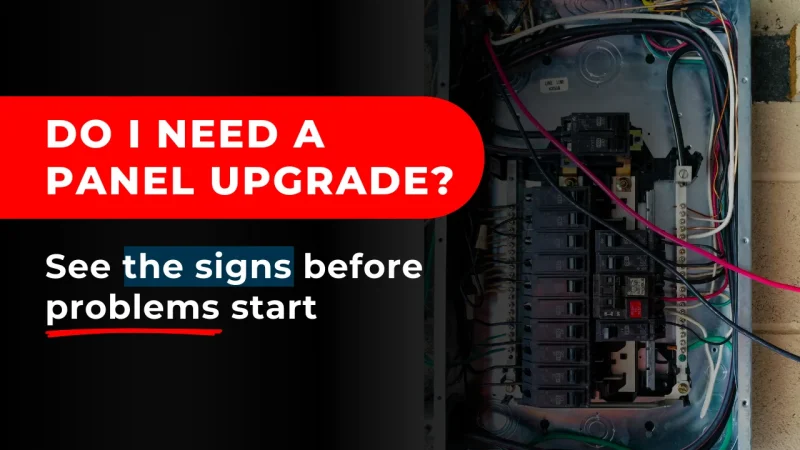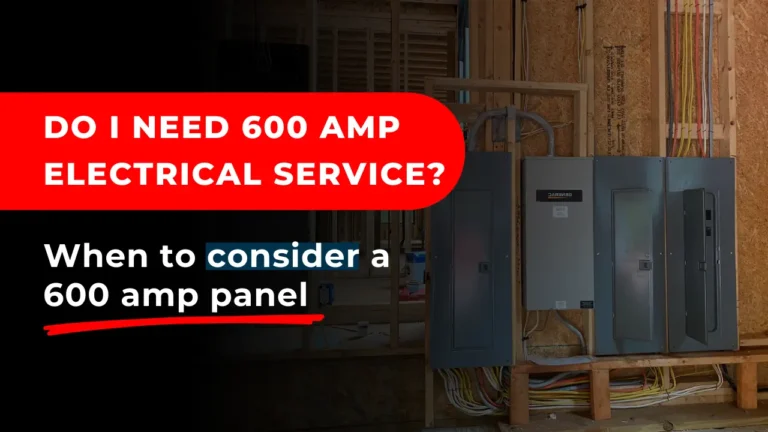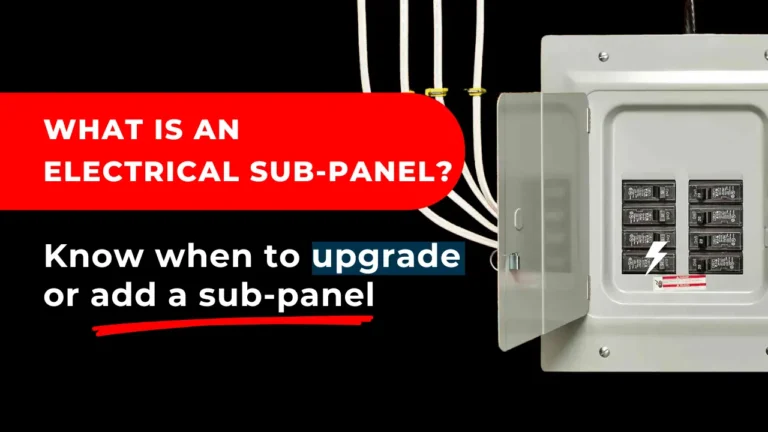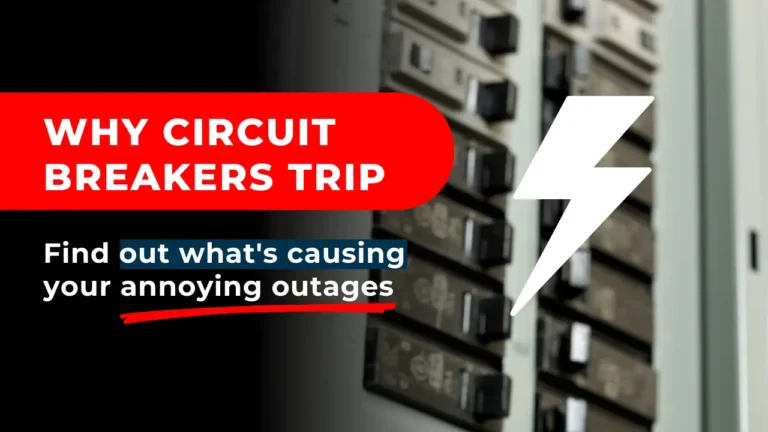Most homeowners don’t think twice about their electrical panel until something goes wrong. Maybe the lights flicker. Maybe you’re installing an EV charger. Or maybe your insurance company raises a red flag.
Your panel is the heart of your home’s electrical system. If it’s outdated or overloaded, it can create real risks like fire hazards, denied claims, and even failed inspections. But how do you know if yours needs to be replaced?
This post walks through the signs, triggers, and next steps. Not everyone needs a new panel. But if you do, it’s better to find out before it becomes a problem. If you’ve ever asked, “Do I need to upgrade my electrical panel?”, this guide is for you.
To understand what’s involved in a typical electrical panel replacement, including timing, ESA permits, and common triggers, we’ve laid it all out here.
If you’re just looking for a quick way to assess your electrical panel, jump to our Panel Upgrade Calculator and find out for yourself!
Signs your electrical panel needs replacement
Some issues are obvious. Others are easy to miss. Here’s what to look for if you’re asking yourself, “do I need to upgrade my electrical panel?”:
- You have a 60-amp panel or fuse box. These systems were common decades ago, but most modern homes need at least 100 amps, especially with things like heat pumps, hot tubs, or EVs.
- Breakers trip often. If your system can’t handle multiple appliances or tools at once, it’s likely over capacity.
- You see rust, heat marks, or smell burning. These are major red flags. Get it checked immediately.
- Buzzing or flickering lights. This could signal loose wiring or insufficient load capacity.
- ESA inspection raised concerns. If you’ve already had an inspection that flagged panel issues, it’s time to act.

Some of these signs are safety-related. Others are more performance-related or future planning. Either way, they’re worth a closer look.
Why “Do I Need to Upgrade My Electrical Panel?” Is the Right Question
Electrical panels are rated by amperage. Measuring things like how much load they can safely distribute at once. Here’s what that means to you:
- 60A panels are outdated and usually can’t support today’s appliances
- 100A is the minimum in most homes, but often maxed out with additions like EV chargers
- 200A is becoming the new standard, especially in renovated or larger properties
Your home’s electrical load grows every time you add something with a significant draw: a heat pump, hot tub, EV charger, or basement suite.
A proper load calculation, done by a licensed electrician, can determine whether your panel can safely support everything. It involves reviewing the size of your home, your major appliances, heating systems, and expected electrical use. They’ll assess both continuous and peak loads to ensure your panel isn’t running close to its maximum capacity. This is especially important in homes adding electric vehicles or high-draw heating/cooling systems.
And in Ontario, panel upgrades require permits and ESA inspection. It’s not optional. It’s the law.
What not to assume
There are a few common misunderstandings that lead people astray:
- “If it’s working, it must be fine.” Not always. A panel can function while still posing a risk.
- “I’ll just add a subpanel.” Subpanels don’t increase capacity. They only distribute existing power differently.
- “My insurance provider hasn’t said anything.” Many policies require disclosure, and they may not cover claims tied to outdated panels. These insurance electrical panel requirements often appear in fine print, but ignoring them can cost you.
- “Any electrician can do it.” Only ESA-licensed electricians can legally perform panel upgrades in Ontario.
According to the Electrical Safety Authority (ESA), there has been a 6% decrease in electrical fires in Ontario between 2017 and 2021, attributed to improved safety measures and code compliance. (Source: Electrical Industry Newsweek)
When in doubt, ask. A no-pressure assessment will give you clear answers.

Frequently Asked Questions
Can I add a subpanel instead of upgrading my main panel?
Only if your main panel has sufficient capacity. A subpanel adds extra space, not extra amperage.
How long does a panel upgrade take?
Most upgrades can be completed in a day. However, permits and ESA inspection timelines should be factored in during planning.
Does upgrading my panel increase home value?
It can. While not a flashy renovation, a code-compliant 200A panel is a strong signal of a well-maintained and future-ready home.
When to replace your electrical panel: Real-world reasons people upgrade

Here’s when clients usually reach out:
- They’re installing an EV charger and hit a load issue
- An insurance renewal flagged a concern about fuse boxes or amp size
- A real estate sale or pre-purchase inspection revealed problems
- They’re doing a renovation (like a basement or HVAC upgrade)
- The panel is physically deteriorating: corrosion, heat, and water damage

For Hamilton-area homes, fuse boxes and aluminum wiring are especially common in older neighbourhoods. These raise insurance and safety concerns more frequently. Some insurers may even refuse coverage or require replacement as a condition for renewal. Real estate deals are sometimes delayed or fall through if these issues aren’t addressed quickly and properly. If your home was built before 1975 and hasn’t had a recent panel update, it’s worth checking.
Fuse Panel vs Breaker Panel: What’s the Difference?
- Fuse panels rely on replaceable fuses that burn out when overloaded. While they work, they’re more prone to failure and often lack the capacity for today’s electrical demands.
- Breaker panels use resettable switches and are the standard in modern homes. They’re safer, easier to maintain, and easier to expand if needed.
If your home still has a fuse box, most electricians will recommend upgrading as a safety and insurance precaution.
Still unsure? Use our Panel Upgrade Calculator
If you’re still asking, “Do I need to upgrade my electrical panel?”, this quick tool can help. It’s built around the same decision paths our electricians use during assessments.
Answer four simple questions to see whether your panel might be due for an upgrade, or if you’re likely in the clear (for now).
Panel Upgrade Decision Calculator
This calculator is for general guidance only. Every home is different, and even if your answers don’t indicate an urgent issue, unseen risks may still exist. When in doubt, the safest step is always a professional assessment by a licensed electrician.

This isn’t a substitute for an in-person inspection, but it gives you a clear starting point. If your answers point toward action, keep reading, we’ll explain what to do next.
Next steps for your electrical panel upgrade
You don’t need to guess. Here’s how to move forward:
- Book a licensed electrician for a panel assessment
- Request a load calculation to understand current and future needs
- Get a permit and inspection plan if an upgrade is needed
- Choose timing based Choose timing based on lifestyle and budget. If you’re comparing options, it also helps to understand the cost to upgrade an electrical panel so you can plan with confidence.
If you’re still wondering if you need to upgrade your electrical panel, the best way to know is to get an expert opinion.
Be clear before it becomes a problem
If your panel is older, overworked, or visibly worn, it’s worth finding out where you stand. A safe, code-compliant panel protects your home, plans, and peace of mind.
ElectricSafe offers:
- ESA-certified electricians
- No-pressure, code-first assessments
- Clean, high-quality panel upgrades
Still asking yourself, “Do I need to upgrade my electrical panel?” You’re not alon,e and we’re here to help.




